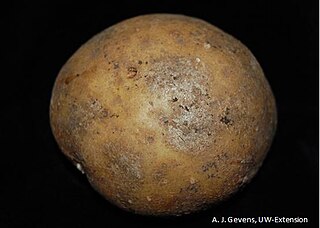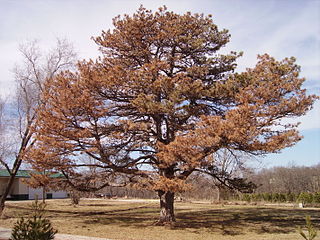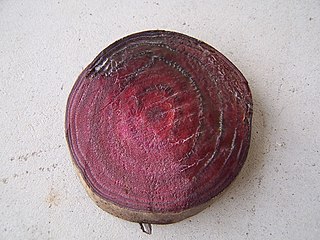
Fire blight, also written fireblight, is a contagious disease affecting apples, pears, and some other members of the family Rosaceae. It is a serious concern to apple and pear producers. Under optimal conditions, it can destroy an entire orchard in a single growing season.

Erwinia is a genus of Enterobacterales bacteria containing mostly plant pathogenic species which was named for the famous plant pathologist, Erwin Frink Smith. It contains Gram-negative bacteria related to Escherichia coli, Shigella, Salmonella, and Yersinia. They are primarily rod-shaped bacteria.

A leaf spot is a limited, discoloured, diseased area of a leaf that is caused by fungal, bacterial or viral plant diseases, or by injuries from nematodes, insects, environmental factors, toxicity or herbicides. These discoloured spots or lesions often have a centre of necrosis. Symptoms can overlap across causal agents, however differing signs and symptoms of certain pathogens can lead to the diagnosis of the type of leaf spot disease. Prolonged wet and humid conditions promote leaf spot disease and most pathogens are spread by wind, splashing rain or irrigation that carry the disease to other leaves.

Stewart's wilt is a bacterial disease of corn caused by the bacterium Pantoea stewartii. The disease is also known as bacterial wilt or bacterial leaf blight and has been shown to be quite problematic in sweet corn. The causal organism is a facultatively anaerobic, gram-negative, rod-shaped bacterium. The disease is endemic in the mid-Atlantic and Ohio River Valley regions and in the southern portion of the Corn Belt. Stewart's Wilt causes minor reductions in field corn yield, despite common occurrence, because most hybrids grown in the Midwest have adequate resistance. However, the disease can be problematic in seed production because many countries have restrictions on maize seed from areas where the Stewart's Wilt occurs.

Dickeya dadantii is a gram-negative bacillus that belongs to the family Pectobacteriaceae. It was formerly known as Erwinia chrysanthemi but was reassigned as Dickeya dadantii in 2005. Members of this family are facultative anaerobes, able to ferment sugars to lactic acid, have nitrate reductase, but lack oxidases. Even though many clinical pathogens are part of the order Enterobacterales, most members of this family are plant pathogens. D. dadantii is a motile, nonsporing, straight rod-shaped cell with rounded ends, much like the other members of the genus, Dickeya. Cells range in size from 0.8 to 3.2 μm by 0.5 to 0.8 μm and are surrounded by numerous flagella (peritrichous).

Clavibacter michiganensis is an aerobic non-sporulating Gram-positive plant pathogenic actinomycete of the genus Clavibacter. Clavibacter michiganensis has several subspecies. Clavibacter michiganensis subsp. michiganensis causes substantial economic losses worldwide by damaging tomatoes and potatoes.

Phytophthora erythroseptica—also known as pink rot along with several other species of Phytophthora—is a plant pathogen. It infects potatoes causing their tubers to turn pink and damages leaves. It also infects tulips (Tulipa) damaging their leaves and shoots.

Pectobacterium carotovorum is a bacterium of the family Pectobacteriaceae; it used to be a member of the genus Erwinia.

Helminthosporium solani is a fungal plant pathogen responsible for the plant disease known as silver scurf. Silver scurf is a blemish disease, meaning the effect it has on tubers is mostly cosmetic and affects "fresh market, processing and seed tuber potatoes." There are some reports of it affecting development, meaning growth and tuber yield. This is caused by light brown lesions, which in turn change the permeability of tuber skin and then it causes tuber shrinkage and water loss, which finally causes weight loss. The disease has become economically important because silver scurf affected potatoes for processing and direct consumption have been rejected by the industry. The disease cycle can be divided into two stages: field and storage. It is mainly a seed borne disease and the primary source of inoculum is mainly infected potato seed tubers. Symptoms develop and worsen in storage because the conditions are conducive to sporulation. The ideal conditions for the spread of this disease are high temperatures and high humidity. There are also many cultural practices that favor spread and development. There are multiple ways to help control the disease.
Ditylenchus destructor is a plant pathogenic nematode commonly known as the potato rot nematode. Other common names include the iris nematode, the potato tuber eelworm and the potato tuber nematode. It is an endoparasitic, migratory nematode commonly found in areas such as the United States, Europe, central Asia and Southern Africa.

Bacterial wilt is a complex of diseases that occur in plants such as Cucurbitaceae and Solanaceae and are caused by the pathogens Erwinia tracheiphila, a gram-negative bacterium, or Curtobacterium flaccumfaciens pv. flaccumfaciens, a gram-positive bacterium. Cucumber and melon plants are most susceptible, but squash, pumpkins, and gourds may also become infected.
Rhizopus soft rot is a disease of the sweet potato. It is one of the most common to affect the sweet potato, happening during packing and shipping. The disease causes a watery soft rot of the internal portion of the storage root. Strategies to manage the disease include the development of resistant varieties, curing through the use of heat and humidity, and application of decay control products.

Phalaenopsis bellina is an orchid endemic to Borneo. It is one of 75 species of Phalaenopsis and one of the most commonly cultivated species in the genus.

A wilt disease is any number of diseases that affect the vascular system of plants. Attacks by fungi, bacteria, and nematodes can cause rapid killing of plants, large tree branches or even entire trees.
Black rot, caused by the bacterium Xanthomonas campestris pv. campestris (Xcc), is considered the most important and most destructive disease of crucifers, infecting all cultivated varieties of brassicas worldwide. This disease was first described by botanist and entomologist Harrison Garman in Lexington, Kentucky, US in 1889. Since then, it has been found in nearly every country in which vegetable brassicas are commercially cultivated.

Dickeya solani is a bacterium that causes blackleg and soft rot in potato crops. Its symptoms are often indistinguishable from those caused by Pectobacterium but is more virulent, causing disease from lower levels of inoculum and spreading through the plant more effectively.

Beet vascular necrosis and rot is a soft rot disease caused by the bacterium Pectobacterium carotovorum subsp. betavasculorum, which has also been known as Pectobacterium betavasculorum and Erwinia carotovora subsp. betavasculorum. It was classified in the genus Erwinia until genetic evidence suggested that it belongs to its own group; however, the name Erwinia is still in use. As such, the disease is sometimes called Erwinia rot today. It is a very destructive disease that has been reported across the United States as well as in Egypt. Symptoms include wilting and black streaks on the leaves and petioles. It is usually not fatal to the plant, but in severe cases the beets will become hollowed and unmarketable. The bacteria is a generalist species which rots beets and other plants by secreting digestive enzymes that break down the cell wall and parenchyma tissues. The bacteria thrive in warm and wet conditions, but cannot survive long in fallow soil. However, it is able to persist for long periods of time in the rhizosphere of weeds and non-host crops. While it is difficult to eradicate, there are cultural practices that can be used to control the spread of the disease, such as avoiding injury to the plants and reducing or eliminating application of nitrogen fertilizer.

Blackleg is a plant disease of potato caused by pectolytic bacteria that can result in stunting, wilting, chlorosis of leaves, necrosis of several tissues, a decline in yield, and at times the death of the potato plant. The term "blackleg" originates from the typical blackening and decay of the lower stem portion, or "leg", of the plant.
Erwinia papayae is a bacteria species causing bacterial crown rot, or bacterial canker, a noteworthy and grave disease of papaya.
Clavibacter sepedonicus is a species of bacteria in the genus Clavibacter. C. sepedonicus is a high-profile alien plant pathogen of A2 Quarantine status affecting only potatoes. It causes a disease in potatoes known as 'ring rot' due to the way it rots vascular tissue inside potato tubers It is present in parts of Europe but is under statutory control under 'Council Directive 93/85/EEC' of 4 October 1993 on the control of potato ring rot. This means that if an outbreak occurs, the outbreak must be controlled and if possible the disease has to be eradicated. If necessary, prohibitions are put into place to prevent further spread.















